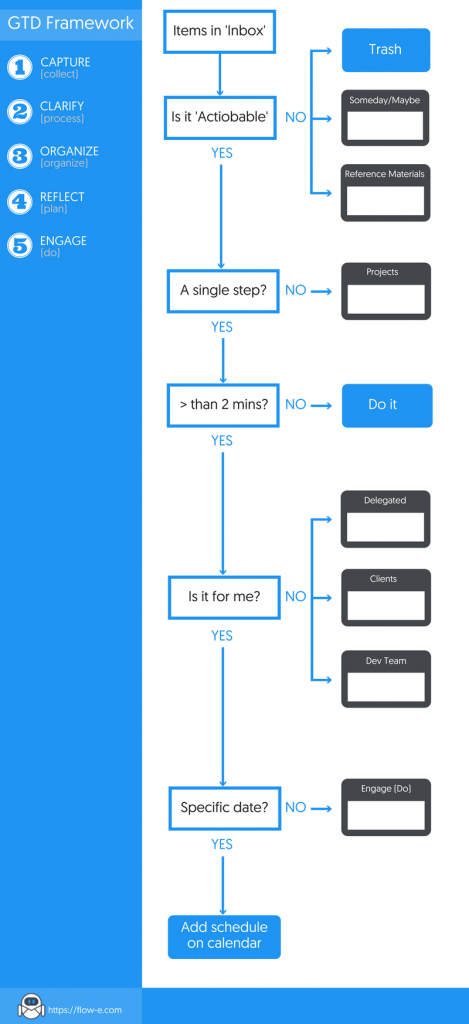What is the GTD Process?
Getting Things Done is a productivity method, created by David Allen in 2001. The GTD method consists of five stages:
• Capture (collect)
• Clarify (process)
• Organize
• Reflect (plan)
• Engage (do)
One of the most complex stages of the GTD method is learning to process “stuff.”
The GTD process stage, also known as Clarify, is about clarifying the items in the Capture list and decide what you are going to do with all the tasks and emails you have already collected.
Think about this stage in the following way. You have an inbox full of indefinite and amorphous “stuff” that needs to be set correctly and organized into proper actions. To tame the chaos in your email inbox, so to speak.
4 Fundamental Processing Question to Ask:
1. What is it?
2. Is it actionable?
3. What’s the desired outcome? If multi-step, write it on your Projects list (column).
4. What’s the next action? Write it on the Engage (Do) list.
Since this stage is crucial to be up-to-date, below we provide a list of best practices to follow and be able to clarify your work items efficiently.
1) Process your inbox as often as possible
We call unprocessed stuff all the ideas, indefinite tasks, thoughts. Until you shape them, they will be hitting your head. A process as often as you can until you get the feeling that everything is clean and control.
2) Process one item at a time
Process each item in isolation and don’t allow to be distracted by other items. Just focus on each item separately to be able to make the best decision. Keep in mind that processing is not doing, it is deciding, and you need to focus.
3) Process your to-do list consequently
It is essential to process your list in sequential order; this means that you should not prioritize at this stage. As we mentioned above, this stage is for deciding where your items should go – trash, maybe/someday, projects, delegation. Don’t leave tasks unprocessed, because you will start to procrastinate tasks and your productivity system will fail.
4) Reach inbox zero
No matter how difficult it may be to decide, don’t leave any item in your email feed. You have to empty your inbox and process all the emails and the tasks coming from emails. This is precisely the purpose of clarifying.
5) Don’t restore emails into the inbox
The habit to return items to the mailbox is unproductive. So it is the habit to mark an email as unread, once it is read. Don’t do it. Once you open an email or a task and you have clarified what the task is, you should act on it.
6) Use one app for managing your tasks and email accounts
The best way to stay focused is to use one application which will allow you to centralize your work in one place – handling emails, tasks, events, and meetings. Reduce the number of personal management applications you use.
7) Block time for clarifying tasks
The GTD stages require a different mental attitude. Instead of interrupting your work by regularly checking your email and trying to process what comes to your mind, try to block a particular time of the day for clarifying tasks and emails.
8) Restrict the time you spend on a single task to clarify
In the processing stage the question isn’t to do the job, but to understand what every work task is. Also, it is essential to define the next physical action you need to take to move forward. The process of clarifying each item should be tightened up to a minute.
9) Keep your Project lists (column) updated
You have to create the habit of updating your Projects column regularly. If a task requires more than one action to complete then add it to the Project column as a separate project (because it takes more than one action). This Project column (list) reminds you that there are still things to do before you complete it.
10) Delegated tasks
In the process of clarifying tasks, you will find such tasks that have to be completed by someone else. In this case, make sure to move them to the particular delegate list/column. This way you can keep track and follow up later.
11) Don’t skip the two-minute rule
The two-minute rule practically says that if an action requires less than two minutes to complete, then do it right away and don’t procrastinate.
Getting Things Done Flowchart
Read also:
Tutorial
Ready to get started?
Step-by-step instructions on how to use the Getting Things Done method to manage a project, prioritize your work, and visualize your workflow with Flow-e.
up next
Boost your productivity with GTD for Gmail workflow
Not each person’s workflow will be the same as the nature of our work is different for each individual.
The GTD workflow requires the presence of lists. In Flow-e lists are represented by columns.
